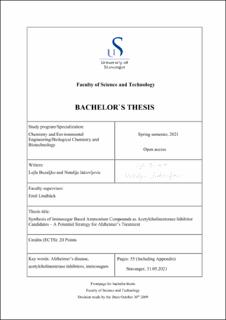| dc.contributor.advisor | Lindbäck Emil | |
| dc.contributor.author | Buzaljko Lejla | |
| dc.contributor.author | Jakovljevic Natalija | |
| dc.date.accessioned | 2021-09-07T16:26:43Z | |
| dc.date.available | 2021-09-07T16:26:43Z | |
| dc.date.issued | 2021 | |
| dc.identifier | no.uis:inspera:79698275:35963364 | |
| dc.identifier.uri | https://hdl.handle.net/11250/2774274 | |
| dc.description.abstract | Alzheimer’s disease accounts for 60–70% of cases of dementia worldwide, with an estimated global incidence of 50 million cases. Alzheimer’s disease is a chronic and fatal illness that causes progressive deterioration of the central nervous system. Cholinergic deficiency is associated with Alzheimer’s disease, and various cholinesterase inhibitors have been developed as lead compounds for the treatment of Alzheimer’s disease, including naturally derived inhibitors, synthetic analogues and hybrids. Due to the multifactorial nature of Alzheimer’s disease, no cure is available for this fatal disease despite huge efforts by the pharmaceutical industry and academia. Indeed, nowadays, the health care system is only able to alleviate the symptoms of Alzheimer’s disease patients by providing drugs which belong to the class of drugs called acetylcholinesterase inhibitors.
Through recent studies it has been shown that iminosugars armed with suitable hydrophobic groups behave as very potent acetylcholinesterase inhibitors. Inspired by the very potent acetylcholinesterase inhibitor edrophonium 1 that hosts a permanent positive charge in its ammonium group, in this thesis we aimed to convert an iminosugar into an ammonium compound 11 that also hosts a permanent positive charge on its nitrogen atom. Compound 11 was successfully synthesized in seven steps starting from commercially available L-xylose in an overall total yield of 8%. The synthetic strategy for achieving this was to treat the pyrrolidine 9 with 1,4-dibromobutane and Pd/C catalyzed reduction, which triggered the N-spiro cyclization of the iminosugar into a quaternary ammonium salt 11 hosting a positive charge on the nitrogen atom. | |
| dc.description.abstract | Alzheimer’s disease accounts for 60–70% of cases of dementia worldwide, with an estimated global incidence of 50 million cases. Alzheimer’s disease is a chronic and fatal illness that causes progressive deterioration of the central nervous system. Cholinergic deficiency is associated with Alzheimer’s disease, and various cholinesterase inhibitors have been developed as lead compounds for the treatment of Alzheimer’s disease, including naturally derived inhibitors, synthetic analogues and hybrids. Due to the multifactorial nature of Alzheimer’s disease, no cure is available for this fatal disease despite huge efforts by the pharmaceutical industry and academia. Indeed, nowadays, the health care system is only able to alleviate the symptoms of Alzheimer’s disease patients by providing drugs which belong to the class of drugs called acetylcholinesterase inhibitors.
Through recent studies it has been shown that iminosugars armed with suitable hydrophobic groups behave as very potent acetylcholinesterase inhibitors. Inspired by the very potent acetylcholinesterase inhibitor edrophonium 1 that hosts a permanent positive charge in its ammonium group, in this thesis we aimed to convert an iminosugar into an ammonium compound 11 that also hosts a permanent positive charge on its nitrogen atom. Compound 11 was successfully synthesized in seven steps starting from commercially available L-xylose in an overall total yield of 8%. The synthetic strategy for achieving this was to treat the pyrrolidine 9 with 1,4-dibromobutane and Pd/C catalyzed reduction, which triggered the N-spiro cyclization of the iminosugar into a quaternary ammonium salt 11 hosting a positive charge on the nitrogen atom. | |
| dc.language | eng | |
| dc.publisher | uis | |
| dc.title | Synthesis of Iminosugar Based Ammonium Compounds as Acetylcholinesterase Inhibitor Candidates – A Potential Strategy for Alzheimer’s Treatment | |
| dc.type | Bachelor thesis | |
